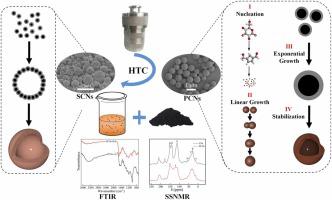当前位置:
X-MOL 学术
›
J. Supercrit. Fluids
›
论文详情
Our official English website, www.x-mol.net, welcomes your feedback! (Note: you will need to create a separate account there.)
Elucidating the intrinsic core-shell structure of carbon nanospheres from glucose hydrothermal carbonization
The Journal of Supercritical Fluids ( IF 3.9 ) Pub Date : 2024-04-23 , DOI: 10.1016/j.supflu.2024.106290 Yilun Luo , Taotao Lu , Shi Jin , Kai Ye , Shaoming Yu , Xianlong Zhang , Xueping Wu , Peiyong Ma , Jefferson W. Tester , Kui Wang
The Journal of Supercritical Fluids ( IF 3.9 ) Pub Date : 2024-04-23 , DOI: 10.1016/j.supflu.2024.106290 Yilun Luo , Taotao Lu , Shi Jin , Kai Ye , Shaoming Yu , Xianlong Zhang , Xueping Wu , Peiyong Ma , Jefferson W. Tester , Kui Wang

|
This study explores the core-shell structure formation mechanisms of primary carbon nanospheres (PCNs) through hydrothermal carbonization (HTC) of glucose at 200 °C, focusing on key phase-change polymerization reactions. Colloidal carbon nanoparticles in the aqueous phase filtrate self-assembled into secondary carbon nanospheres (SCNs) with intrinsic hollow structures during room temperature storage. FTIR results revealed similar functional groups on the surfaces of PCNs and SCNs due to esterification reactions during HTC cooling. XPS and C NMR analyses identified HMF aldol condensation and etherification as dominant reactions for PCNs, while esterification and aldol condensation with levulinic acid were dominant for SCNs. The hypothesis suggests that PCNs initially formed hollow microframeworks but collapsed due to consumption of encapsulated organics, resulting in hydrophobic cores. These cores grew through aggregation (linear) and surface reactions (exponential), internalizing hydrophilic surfaces into hydrophobic cores, forming the final core-shell structure of PCNs.
中文翻译:

阐明葡萄糖水热碳化碳纳米球的内在核壳结构
本研究探讨了通过 200 °C 葡萄糖水热碳化 (HTC) 形成初级碳纳米球 (PCN) 的核壳结构机制,重点关注关键的相变聚合反应。在室温储存期间,水相滤液中的胶体碳纳米颗粒自组装成具有固有中空结构的二次碳纳米球(SCN)。 FTIR 结果显示,由于 HTC 冷却过程中的酯化反应,PCN 和 SCN 表面上存在相似的官能团。 XPS 和 13C NMR 分析表明,HMF 羟醛缩合和醚化是 PCN 的主要反应,而酯化和与乙酰丙酸的羟醛缩合是 SCN 的主要反应。该假设表明,PCN 最初形成中空微框架,但由于封装的有机物的消耗而塌陷,形成疏水核心。这些核通过聚集(线性)和表面反应(指数)生长,将亲水表面内化为疏水核,形成PCN的最终核壳结构。
更新日期:2024-04-23
中文翻译:

阐明葡萄糖水热碳化碳纳米球的内在核壳结构
本研究探讨了通过 200 °C 葡萄糖水热碳化 (HTC) 形成初级碳纳米球 (PCN) 的核壳结构机制,重点关注关键的相变聚合反应。在室温储存期间,水相滤液中的胶体碳纳米颗粒自组装成具有固有中空结构的二次碳纳米球(SCN)。 FTIR 结果显示,由于 HTC 冷却过程中的酯化反应,PCN 和 SCN 表面上存在相似的官能团。 XPS 和 13C NMR 分析表明,HMF 羟醛缩合和醚化是 PCN 的主要反应,而酯化和与乙酰丙酸的羟醛缩合是 SCN 的主要反应。该假设表明,PCN 最初形成中空微框架,但由于封装的有机物的消耗而塌陷,形成疏水核心。这些核通过聚集(线性)和表面反应(指数)生长,将亲水表面内化为疏水核,形成PCN的最终核壳结构。































 京公网安备 11010802027423号
京公网安备 11010802027423号